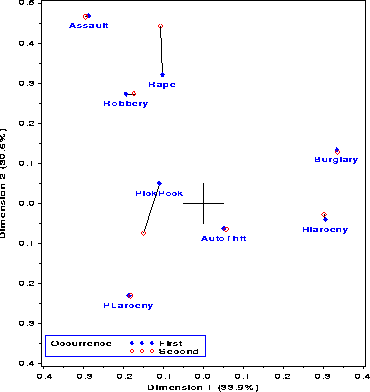| equate | Create AXIS statements for a GPLOT with equated axes | equate |
AXIS statements for a GPLOT with equated axes, and optionally produces a plot
using point labels (supplied in an input annotate data set).
It is used as a utility macro to create plots where angles between vectors
and distances between points have
meaning, so the axes should be scaled to the same physical units.
For the vertical axis variable Y it creates (by default)
an AXIS98 statement and for horizontal axis variable X it creates an AXIS99 statement. These use the ORDER=
and LENGTH= parameters to ensure
that an inch on the vertical axis represents the same data
range as an inch on the horizontal axis.
If the maximum plot dimensions XMAX= and YMAX= are not specified, the EQUATE macro uses the GASK call to obtain the maximum values from the device driver.
%equate(data=inputdataset, X=xvar, Y=yvar, ..., )
Reset the defaults below to be more suited to your devices.
As well, use GOPTIONS HSIZE= VSIZE=; to allow the maximum plot size if you do not specify the XMAX and YMAX
parameters.
PLOT=YES)
PLOT=YES.

%include vcd(equate); *-- or include in an autocall library;
%include vcd(corresp); *-- or include in an autocall library;
data victims;
input crime $ Rape Assault Robbery PickPock PLarceny
Burglary HLarceny AutoThft;
cards;
Rape 26 50 11 6 82 39 48 11
Assault 65 2997 238 85 2553 1083 1349 216
Robbery 12 279 197 36 459 197 221 47
PickPock 3 102 40 61 243 115 101 38
PLarceny 75 2628 413 329 12137 2658 3689 687
Burglary 52 1117 191 102 2649 3210 1973 301
Hlarceny 42 1251 206 117 3757 1962 4646 391
AutoThft 3 221 51 24 678 301 367 269
;
%corresp(data=victims, id=crime,
var=Rape Assault Robbery PickPock PLarceny Burglary HLarceny AutoThft,
pos=8, gplot=NO, anno=labels);
An Annotate data set LINES is then created to draw the
lines, and is appended to the ANNO=LABELS
*-- Sort crimes by upcase(_name);
data coord;
set coord;
_name_ = upcase(_name_);
proc sort data=coord;
where (_type_ ^= 'INERTIA');
by _name_ _type_;
*-- Join first/second occurrence;
data lines;
set coord(keep=_name_ _type_ dim1 dim2);
by _name_ _type_;
xsys='2'; ysys='2';
x = dim1; y = dim2;
if first._name_
then function='MOVE';
else function='DRAW';
*-- Remove _type_='VAR' labels, and add lines;
data label;
set label(where=(_type_^='VAR')) lines;
Finally, we generate AXIS statements using EQUATE, and produce the
plot
%equate(data=coord, x=dim1, y=dim2, plot=no, vaxis=axis98, haxis=axis99,
xmextra=1, ymextra=1);
proc gplot data=coord;
plot dim2 * dim1 = _type_
/ anno=label frame legend=legend1
vaxis=axis98 haxis=axis99 vminor=1 hminor=1;
symbol1 h=1.2 v=dot c=blue;
symbol2 h=1.2 v=circle c=red;
legend1 position=(bottom inside left) offset=(1,2)
mode=share cborder=blue
across=1 shape=symbol(6,1.5)
label=('Occurrence') value=('First' 'Second');
run;